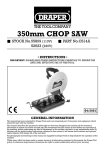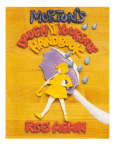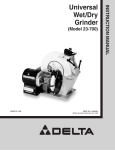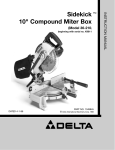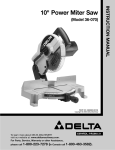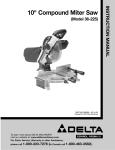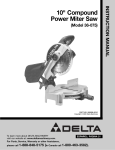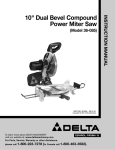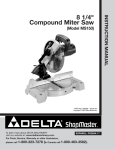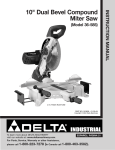Download Delta 20-140 Instruction manual
Transcript
(Model 20-140) DATED 12-8-95 PART NO. 1349487 ©Delta International Machinery Corp. 1995 INSTRUCTION MANUAL 14" Abrasive Cut-Off Saw TABLE OF CONTENTS SAFETY RULES . . . . . . . . . . . . . . . . . . . . . . . . . . . . . . . . . . . . . . . . . . . . . . . . . . . . . . . . . . . . . . . . 3 ADDITIONAL SAFETY RULES FOR ABRASIVE CUT-OFF SAWS . . . . . . . . . . . . . . . . . . . . . . . . 4 UNPACKING. . . . . . . . . . . . . . . . . . . . . . . . . . . . . . . . . . . . . . . . . . . . . . . . . . . . . . . . . . . . . . . . . . . 5 MOVING CUTTINGHEAD TO THE UP POSITION . . . . . . . . . . . . . . . . . . . . . . . . . . . . . . . . . . . . . 5 CONNECTING SAW TO POWER SOURCE Power Connections . . . . . . . . . . . . . . . . . . . . . . . . . . . . . . . . . . . . . . . . . . . . . . . . . . . . . . . . . 6 Motor Specifications . . . . . . . . . . . . . . . . . . . . . . . . . . . . . . . . . . . . . . . . . . . . . . . . . . . . . . . . 6 Grounding Instructions . . . . . . . . . . . . . . . . . . . . . . . . . . . . . . . . . . . . . . . . . . . . . . . . . . . . . . 6 Extension Cords. . . . . . . . . . . . . . . . . . . . . . . . . . . . . . . . . . . . . . . . . . . . . . . . . . . . . . . . . . . . 7 OPERATING CONTROLS AND ADJUSTMENTS On-Off Switch. . . . . . . . . . . . . . . . . . . . . . . . . . . . . . . . . . . . . . . . . . . . . . . . . . . . . . . . . . . . . . 7 Locking Switch In The “OFF” Position . . . . . . . . . . . . . . . . . . . . . . . . . . . . . . . . . . . . . . . . . 7 Vise . . . . . . . . . . . . . . . . . . . . . . . . . . . . . . . . . . . . . . . . . . . . . . . . . . . . . . . . . . . . . . . . . . . . . . 8 Angle Cutting . . . . . . . . . . . . . . . . . . . . . . . . . . . . . . . . . . . . . . . . . . . . . . . . . . . . . . . . . . . . . . 8 Adjusting Downward Travel Of Abrasive Wheel . . . . . . . . . . . . . . . . . . . . . . . . . . . . . . . . . . 9 Wrench Storage . . . . . . . . . . . . . . . . . . . . . . . . . . . . . . . . . . . . . . . . . . . . . . . . . . . . . . . . . . . . 9 Carrying Handle . . . . . . . . . . . . . . . . . . . . . . . . . . . . . . . . . . . . . . . . . . . . . . . . . . . . . . . . . . . . 9 OPERATION . . . . . . . . . . . . . . . . . . . . . . . . . . . . . . . . . . . . . . . . . . . . . . . . . . . . . . . . . . . . . . . . . . 10 MAINTENANCE Changing The Wheel . . . . . . . . . . . . . . . . . . . . . . . . . . . . . . . . . . . . . . . . . . . . . . . . . . . . . . . 11 Brush Inspection And Replacement . . . . . . . . . . . . . . . . . . . . . . . . . . . . . . . . . . . . . . . . . . 12 WARRANTY . . . . . . . . . . . . . . . . . . . . . . . . . . . . . . . . . . . . . . . . . . . . . . . . . . . . . . . . . . . . . . . . . . 12 2 SAFETY RULES Woodworking can be dangerous if safe and proper operating procedures are not followed. As with all machinery, there are certain hazards involved with the operation of the product. Using the machine with respect and caution will considerably lessen the possibility of personal injury. However, if normal safety precautions are overlooked or ignored, personal injury to the operator may result. Safety equipment such as guards, push sticks, hold-downs, featherboards, goggles, dust masks and hearing protection can reduce your potential for injury. But even the best guard won’t make up for poor judgment, carelessness or inattention. Always use common sense and exercise caution in the workshop. If a procedure feels dangerous, don’t try it. Figure out an alternative procedure that feels safer. REMEMBER: Your personal safety is your responsibility. This machine was designed for certain applications only. Delta Machinery strongly recommends that this machine not be modified and/or used for any application other than that for which it was designed. If you have any questions relative to a particular application, DO NOT use the machine until you have first contacted Delta to determine if it can or should be performed on the product. DELTA INTERNATIONAL MACHINERY CORP. MANAGER OF TECHNICAL SERVICES 246 ALPHA DRIVE PITTSBURGH, PENNSYLVANIA 15238 (IN CANADA: 644 IMPERIAL ROAD, GUELPH, ONTARIO N1H 6M7) WARNING: FAILURE TO FOLLOW THESE RULES MAY RESULT IN SERIOUS PERSONAL INJURY 15. DON’T OVERREACH. Keep proper footing and balance at all times. 1. FOR YOUR OWN SAFETY, READ INSTRUCTION MANUAL BEFORE OPERATING THE TOOL. Learn the tool’s application and limitations as well as the specific hazards peculiar to it. 16. MAINTAIN TOOLS IN TOP CONDITION. Keep tools sharp and clean for best and safest performance. Follow instructions for lubricating and changing accessories. 2. KEEP GUARDS IN PLACE and in working order. 17. DISCONNECT TOOLS before servicing and when changing accessories such as blades, bits, cutters, etc. 3. ALWAYS WEAR EYE PROTECTION. 4. GROUND ALL TOOLS. If tool is equipped with threeprong plug, it should be plugged into a three-hole electrical receptacle. If an adapter is used to accommodate a twoprong receptacle, the adapter lug must be attached to a known ground. Never remove the third prong. 18. USE RECOMMENDED ACCESSORIES. The use of accessories and attachments not recommended by Delta may cause hazards or risk of injury to persons. 19. REDUCE THE RISK OF UNINTENTIONAL STARTING. Make sure switch is in “OFF” position before plugging in power cord. 5. REMOVE ADJUSTING KEYS AND WRENCHES. Form habit of checking to see that keys and adjusting wrenches are removed from tool before turning it “on.” 20. NEVER STAND ON TOOL. Serious injury could occur if the tool is tipped or if the cutting tool is accidentally contacted. 6. KEEP WORK AREA CLEAN. Cluttered areas and benches invite accidents. 9. MAKE WORKSHOP CHILDPROOF – with padlocks, master switches, or by removing starter keys. 21. CHECK DAMAGED PARTS. Before further use of the tool, a guard or other part that is damaged should be carefully checked to ensure that it will operate properly and perform its intended function – check for alignment of moving parts, binding of moving parts, breakage of parts, mounting, and any other conditions that may affect its operation. A guard or other part that is damaged should be properly repaired or replaced. 10. DON’T FORCE TOOL. It will do the job better and be safer at the rate for which it was designed. 22. DIRECTION OF FEED. Feed work into a blade or cutter against the direction of rotation of the blade or cutter only. 11. USE RIGHT TOOL. Don’t force tool or attachment to do a job for which it was not designed. 23. NEVER LEAVE TOOL RUNNING UNATTENDED. TURN POWER OFF. Don’t leave tool until it comes to a complete stop. 7. DON’T USE IN DANGEROUS ENVIRONMENT. Don’t use power tools in damp or wet locations, or expose them to rain. Keep work area well-lighted. 8. KEEP CHILDREN AND VISITORS AWAY. All children and visitors should be kept a safe distance from work area. 12. WEAR PROPER APPAREL. No loose clothing, gloves, neckties, rings, bracelets, or other jewelry to get caught in moving parts. Nonslip footwear is recommended. Wear protective hair covering to contain long hair. 24. DRUGS, ALCOHOL, MEDICATION. Do not operate tool while under the influence of drugs, alcohol or any medication. 13. ALWAYS USE SAFETY GLASSES. Wear safety glasses. Everyday eyeglasses only have impact resistant lenses; they are not safety glasses. Also use face or dust mask if cutting operation is dusty. 25. MAKE SURE TOOL IS DISCONNECTED FROM POWER SUPPLY while motor is being mounted, connected or reconnected. 14. SECURE WORK. Use clamps or a vise to hold work when practical. It’s safer than using your hand and frees both hands to operate tool. 26. WARNING: The dust generated by certain woods and wood products can be injurious to your health. Always operate machinery in well ventilated areas and provide for proper dust removal. Use wood dust collection systems whenever 3 ADDITIONAL SAFETY RULES FOR ABRASIVE CUT-OFF SAWS 1. WARNING: Do not operate your abrasive cut-off saw until it is completely assembled and installed according to the instructions. starting cut. 20. AFTER TURNING MACHINE ON, lower wheel lightly until it comes into contact with the workpiece and then draw wheel firmly through the cut. DO NOT allow the wheel to chatter and jump as this may cause the wheel to wear out of round, resulting in poor cutting and possible broken wheels. 2. IF YOU ARE NOT thoroughly familiar with the operation of abrasive cut-off saws, obtain advice from your supervisor, instructor or other qualified person. 3. WEAR safety goggles, face shield, respirator, body apron, headcovering, safety shoes, long tight-fitting sleeves and gloves. 21. ANY material can be cut more satisfactorily when placed in position for the wheel to cut with the least arc of contact. 4. USE ONLY recommended reinforced abrasive wheels with blotters. 22. THE NUMBER of cuts per wheel, as well as the quality of cut, may vary considerably with the cutting time. Fast cuts cause the wheel to wear more rapidly but also help to reduce discoloration and burr. This is especially noticeable when cutting light gage tubing. When coming through the bottom wall, with the longer arc of contact, do not slow-up but give a vigorous pull. This keeps the metal from overheating and dragging off in a heavy burr. 5. TIGHTEN arbor screw and all clamps before operating. 6. MAKE SURE spindle lock is disengaged before operating. 7. ALWAYS keep guards in place and working properly. 8. KEEP hands clear of cut-off wheel. 23. USE the wheel guard at all times. 9. SECURE workpiece properly. Work should be straight and firmly clamped to avoid possible movement and pinching as the cut nears completion. 24. NEVER operate the machine in an area with flammable liquids or gases. 10. NEVER cut anything freehand. 25. TO AVOID electric shock, do not use under damp conditions or expose to rain. 11. NEVER reach behind or beneath the cut-off wheel. 26. THIS tool is designed for ferrous metals only. DO NOT attempt to cut wood, masonry, aluminum or magnesium with this tool. 12. MAKE SURE the wheel has come to a complete stop before removing or securing workpiece or changing workpiece angle. 27. AFTER installing a new wheel, never start the tool with a person in line with the wheel. ALWAYS run the tool for approximately one minute before cutting. If the wheel has an undetected crack or flaw, it could burst in less than one minute. 13. MAKE SURE the inside surfaces of the wheel flanges as well as the sides of the wheel are free from any foreign matter. 14. WHEN MOUNTING the wheel, care should be taken to tighten the arbor screw only enough to hold the wheel firmly and to prevent wheel slippage. Excessive tightening may result in damaging the wheel and springing the wheel flanges. 28. SHUT OFF power before servicing or adjusting tool. 29. SHOULD any part of your machine be missing, damaged or fail in any way, or any electrical component fail to perform properly, shut-off switch and remove plug from power supply outlet. Replace missing, damaged or failed parts before resuming operation. 15. USE ONLY abrasive wheels rated at 3900 RPM or higher. 16. ALWAYS check the wheel for cracks or other damage before operation. Replace cracked or damaged wheel immediately. 30. ADDITIONAL INFORMATION regarding the safe and proper operation of this product is available from the National Safety Council, 1121 Spring Lake Drive, Itasca, IL 60143-3201 in the Accident Prevention Manual for Industrial Operation and also in the Safety Data Sheets provided by the NSC. Please also refer to the American National Standard Institute ANSI 01.1 Safety Require-ments for Woodworking Machinery and the U.S. Depart-ment of Labor OSHA 1910.213 Regulations. 17. USE ONLY wheel flanges specified for your machine. 18. MAKE SURE abrasive wheel is not contacting workpiece before switch is turned on. 19. ALLOW the motor to come up to full speed before 4 UNPACKING Your new 14 Abrasive Cut-Off Saw is shipped complete in one carton. Carefully unpack the saw from the shipping container. Fig. 2 illustrates the saw after it has been removed from the container. Fig. 2 MOVING CUTTINGHEAD TO THE UP POSITION 1. For shipping purposes the cuttinghead (A) Fig. 3, has been clamped in the down position by means of the holddown chain (B). To move the cuttinghead (A) to the up position, simply unhook the chain (B) from the handle housing. 2. Fig. 4 illustrates the cuttinghead in the up position. A B Fig. 3 Fig. 4 5 CONNECTING SAW TO POWER SOURCE POWER CONNECTIONS A separate electrical circuit should be used for your tools. This circuit should not be less than #12 wire and should be protected with a 20 Amp fuse. Have a certified electrician replace or repair a worn cord immediately. Before connecting the motor to a power line, make sure the switch is in the “OFF” position and be sure that the electric current is of the same characteristics as stamped on the motor nameplate. Running on low voltage will damage the motor. WARNING: DO NOT EXPOSE THE TOOL TO RAIN OR OPERATE THE TOOL IN DAMP LOCATIONS. MOTOR SPECIFICATIONS Your saw is wired for 110-120 volt, 60 HZ alternating current. Before connecting the saw to the power source, make sure the switch is in the “OFF” position. GROUNDING INSTRUCTIONS CAUTION: THIS TOOL MUST BE GROUNDED WHILE IN USE TO PROTECT THE OPERATOR FROM ELECTRIC SHOCK. In the event of a malfunction or breakdown, grounding provides a path of least resistance for electric current to reduce the risk of electric shock. This tool is equipped with an electric cord having an equipment-grounding conductor and a grounding plug. The plug must be plugged into a matching outlet that is properly installed and grounded in accordance with all local codes and ordinances. grounded. Use only 3-wire extension cords that have 3-prong grounding types plugs and 3-hole receptacles that accept the tool’s plug, as shown in Fig. 5. Repair or replace damaged or worn cord immediately. Improper connection of the equipment-grounding conductor can result in risk of electric shock. The conductor with insulation having an outer surface that is green with or without yellow stripes is the equipmentgrounding conductor. If repair or replacement of the electric cord or plug is necessary, do not connect the equipment grounding conductor to a live terminal. This tool is intended for use on a circuit that has an outlet and a plug that looks like the one shown in Fig. 5. A temporary adapter, which looks like the adapter illustrated in Fig. 6, may be used to connect this plug to a 2-hole receptacle, as shown in Fig. 6, if a properly grounded outlet is not available. The temporary adapter should be used only until a properly grounded outlet can be installed by a qualified electrician. THIS ADAPTER IS NOT APPLICABLE IN CANADA. The green-colored rigid ear, lug, and the like, extending from the adapter, must be connected to a permanent ground, such as a properly grounded outlet box, as shown in Fig. 6. Check with a qualified electrician or service personnel if the grounding instructions are not completely understood, or if in doubt as to whether the tool is properly CAUTION: IN ALL CASES, MAKE CERTAIN THE RECEPTACLE IN QUESTION IS PROPERLY GROUNDED. IF YOU ARE NOT SURE, HAVE A CERTIFIED ELEC- Do not modify the plug provided - if it will not fit the outlet, have the proper outlet installed by a qualified electrician. GROUNDED OUTLET BOX GROUNDED OUTLET BOX CURRENT CARRYING PRONGS GROUNDING MEANS ADAPTER GROUNDING BLADE IS LONGEST OF THE 3 BLADES Fig. 5 Fig. 6 6 EXTENSION CORDS Use proper extension cords. Make sure your extension cord is in good condition and is a 3-wire extension cord which has a 3-prong grounding type plug and a 3-hole receptacle which will accept the tool’s plug When using an extension cord, be sure to use one heavy enough to carry the current of the saw. An undersized cord will cause a drop in line voltage resulting in loss of power and overheating. Fig. 6A shows the correct gage to use de-pending on cord length. If in doubt, use the next heavier gage. The smaller the gage number, the heavier TOTAL LENGTH OF CORD IN FEET GAGE OF EXTENSION CORD TO USE 0 - 25 26 - 50 51 - 100 101 - 150 14 AWG 12 AWG Not Recommended Not Recommended Fig. 6A OPERATING CONTROLS AND ADJUSTMENTS ON-OFF SWITCH Your 14 Abrasive Cut-Off Saw is provided with an ON-OFF switch that can be used for INTERMEDIATE OPERATION or CONTINUOUS OPERATION, as follows: INTERMEDIATE OPERATION – To turn the saw “ON” depress switch trigger (A) Fig. 7. To turn the saw “OFF” release switch trigger (A). A Fig. 7 CONTINUOUS OPERATION – Depress switch trigger (A) Fig. 8, and push in lock button (B). The saw will remain “ON” until the switch trigger (A) is depressed. B A Fig. 8 LOCKING SWITCH IN THE “OFF” POSITION IMPORTANT: We suggest that when the machine is not in use, the switch be locked in the “OFF” position using a padlock (C) through the holes in the switch trigger (A), as shown in Fig. 9. A C 7 Fig. 9 VISE Clamping the workpiece can be accomplished quickly and easily as follows: E 1. Lift half-nut (A) Fig.10, off screw (B). B 2. Pull out screw handle (C) Fig.10, far enough to allow workpiece (D) to be placed in vise opening against rear vise clamp (E) as shown. NOTE: It is not necessary to thread screw handle (C) when the half-nut (A) is in the raised position. The screw handle (C) can be rapidly pulled out or pushed in. A C D Fig. 10 3. Push in on screw handle (C) Fig. 11, until front vise clamp (F) contacts workpiece (D). 4. Flip half-nut (A) Fig. 11, over to engage screw (B) and tighten screw handle (C) to securely clamp workpiece (D) in the vise. D F B A C Fig. 11 ANGLE CUTTING 1. Loosen two screws (G) Fig. 12, and rotate rear vise clamp (H) to the desired angle. Then tighten the two screws (G). The front vise clamp (F) pivots on its post and will automatically align itself with the workpiece. H G Fig. 12 2. Fig. 13, illustrates a workpiece clamped in the vise for a typical angle cutting operation. 8 Fig. 13 F ADJUSTING DOWNWARD TRAVEL OF ABRASIVE WHEEL A stop screw (A) Fig. 14, is provided to limit the downward travel of the abrasive wheel. This adjustment is made by loosening lock nut (B) and turning stop screw (A) in or out as desired. Then tighten lock nut (B). A B Fig. 14 Fig. 15 illustrates edge of the arm casting (C) contacting stop screw (A), limiting the downward travel of the abrasive wheel. NOTE: As the abrasive wheel becomes smaller in diameter (because of wear), the downward travel of the wheel can be increased. C A Fig. 15 WRENCH STORAGE A built-in clamp (A) Fig. 16, is provided on the back edge of the machine base for convenient storage of the adjusting wrench (B), which is supplied with your machine. A B Fig. 16 Fig. 17 illustrates the wrench (B) stored in position inside the clamp. B Fig. 17 9 CARRYING HANDLE B When transporting the machine, the cuttinghead should always be locked in the down position by means of the holddown chain (A) Fig. 18. A carrying handle (B) is provided for ease of transportation. A Fig. 18 OPERATION After clamping the workpiece securely in the vise, turn the machine on and allow the motor to come up to full speed. Lower the wheel (A) lightly until it comes into contact with the workpiece (B), as shown in Fig. 19. Do not allow the wheel to chatter and jump as this may cause the wheel to wear out of round, resulting in poor quality cutting and possible broken wheels. A B Fig. 19 Continue to push firmly down on the handle while the cut is being made, as shown in Fig. 20 Fig. 20 When coming through the bottom of the cut, as shown in Fig. 21, do not slow up. This keeps the metal from overheating and dragging off in a heavy burr. Fig. 21 10 Fig. 22 illustrates the cut-off piece after the cut is completed. NOTE: The number of cuts per wheel, as well as the quality of cut, may vary considerably with the cutting time. Fast cuts cause the wheel to wear more rapidly, but also help to reduce discoloration and burr. Fig. 22 MAINTENANCE CHANGING THE WHEEL 1. DISCONNECT THE MACHINE FROM THE POWER SOURCE. 2. Rotate the front wheel guard (A) Fig. 23, to the up position, as shown. A Fig. 23 3. Press in on arbor lock (B) Fig. 24, and at the same time rotate wheel (F) by hand until the arbor lock engages. 4. Using the wrench provided, loosen arbor screw (C) Fig. 25, by turning it counterclockwise, and remove arbor screw (C), washer (D), outside wheel flange (E) and wheel (F). DO NOT REMOVE INSIDE WHEEL FLANGE. B 5. Make sure the inside surfaces of both the inside and outside wheel flanges are clean and free from any foreign substance. F 6. Install new wheel (F) Fig. 25, outside wheel flange (E), washer (D) and arbor screw (C). Turn arbor screw (C) clockwise to tighten. IMPORTANT: USE ONLY RECOMMENDED REINFORCED ABRASIVE WHEELS WITH BLOTTERS AND TIGHTEN THE ARBOR SCREW (C) ONLY ENOUGH TO HOLD THE WHEEL FIRMLY AND PREVENT WHEEL SLIPPAGE. EXCESSIVE TIGHTENING MAY RESULT IN DAMAGE TO THE WHEEL AND SPRINGING THE WHEEL FLANGES. Fig. 24 E D C 7. Rotate front wheel guard to the down position and make sure spindle lock is disengaged before turning the machine on. F Fig. 25 11 BRUSH INSPECTION AND REPLACEMENT CAUTION: BEFORE INSPECTING BRUSHES, DISCONNECT THE MACHINE FROM THE POWER SOURCE. A Brush life varies. It depends on the load on the motor. Check the brushes after the first 50 hours of use for a new machine or after a new set of brushes has been installed. Fig. 26 After the first check, examine them after about 10 hours of use until such time that replacement is necessary. The brush holders (A) Fig. 26, are located on the motor housing opposite each other. Fig. 27, illustrates one of the brushes removed for inspection. When the carbon on either brush is worn to 3/16 in length or if either spring or shunt wire is burned or damaged in any way, replace both brushes. If the brushes are found serviceable after removing, reinstall them in the same position as Fig. 27 Two Year Limited Warranty Delta Machinery Delta will repair or replace, at its expense and at its option, any Delta machine, machine part, or machine accessory which in normal use has proven to be defective in workmanship or material, provided that the customer notifies his supplying distributor of the alleged defect within two years from the date of delivery to him, of the product and provides Delta Machinery with reasonable opportunity to verify the defect by inspection. Delta Machinery may require that electric motors be returned prepaid to the supplying distributor or authorized service center for inspection and repair or replacement. Delta Machinery will not be responsible for any asserted defect which has resulted from misuse, abuse or repair or alteration made or specifically authorized by anyone other than an authorized Delta service facility or representative. Under no circumstances will Delta Machinery be liable for incidental or consequential damages resulting from defect i v e products. This warranty is Delta Machinery’s sole warranty and sets forth the customers exclusive remedy, with respect to defective products; all other warranties, express or implied, whether of merchantability, 12 PARTS, SERVICE OR WARRANTY ASSISTANCE All Delta Machines and accessories are manufactured to high quality standards and are serviced by a network of factory service centers and authorized service stations listed in your owner’s manual. To obtain additional information regarding your Delta quality product or to obtain parts, service or warranty assistance, please call or fax Delta’s toll-free ‘hotline’ number. Delta maintains a modern, efficient Parts Distribution Center, maintaining an inventory of over 15,000 parts located in Memphis, Tennessee. Highly qualified and experienced Customer Service Representatives are standing by to assist you on weekdays from 7:00 A.M. to 5:00 P.M. Memphis time. Memphis, TN 38118 4290 Raines Road Phone: (901) 363-8800 800-223-PART FAX: 800-535-6488 13 14 15 Two Year Limited Warranty Delta Machinery Delta will repair or replace, at its expense and at its option, any Delta machine, machine part, or machine accessory which in normal use has proven to be defective in workmanship or material, provided that the customer notifies his supplying distributor of the alleged defect within two years from the date of delivery to him, of the product and provides Delta Machinery with reasonable opportunity to verify the defect by inspection. Delta Machinery may require that electric motors be returned prepaid to the supplying distributor or authorized service center for inspection and repair or replacement. Delta Machinery will not be responsible for any asserted defect which has resulted from misuse, abuse or repair or alteration made or specifically authorized by anyone other than an authorized Delta service facility or representative. Under no circumstances will Delta Machinery be liable for incidental or consequential damages resulting from defect i v e products. This warranty is Delta Machinery’s sole warranty and sets forth the customers exclusive remedy, with respect to defective products; all other warranties, express or implied, whether of merchantability, 16
















